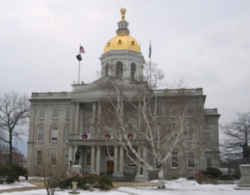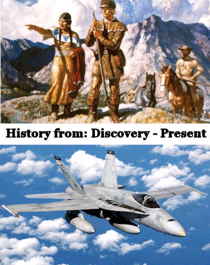
New Hampshire History
Historic Facts & Overview of New Hampshire History
Take a peek at New Hampshire history. Discover an overview of New Hampshire's rich history, heritage, historic events, and culture.
One of the original 13 states (it entered the Union in 1788), New Hampshire was named after the English county of Hampshire. New Hampshire is called the "Granite State" because of its numerous granite quarries; the nickname may also reflect the state's attachment to tradition and its history of a frugal government. There are no general sales or individual income taxes, which fits with the state motto of "Live free or die." A relatively small state, New Hampshire plays a major role every four years in the presidential election, as it holds the first primary election. New Hampshire's state bird is the purple finch and its capital is Concord.
Overview of New Hampshire History and Heritage
The Abenaki and Pennacook Indians were living in the area of New Hampshire when Europeans arrived.
The region was first explored by Martin Pring (1603) and Samuel de Champlain (1605). John Smith explored the Isles of Shoals in 1614, naming them Smith's Islands. In 1620 the Council for New England, formerly the Plymouth Company, received a royal grant of land between lat. 40°N and 48°N. One of the Council's leaders, Sir Ferdinando Gorges, formed a partnership with Capt. John Mason and in 1622 obtained rights between the Merrimack and Kennebec rivers, then called the province of Maine. Under an English land grant, Capt. John Smith sent settlers to establish a fishing colony at the mouth of the Piscataqua River, near present-day Rye and Dover, in 1623. By a division Mason took (1629) the area between the Piscataqua and the Merrimack, naming it New Hampshire. Portsmouth was founded by farmers and fishermen in 1630.
Note: The 1st known European settlement in New Hampshire, Piscataqua, was founded in 1622, not by an Englishman as one might presume, but rather by a Scottish Gentleman, Mr. David Thomson. The "plantation" was part of the colonization of Nova Albion (New England) under the Scottish king...James Stuart the VI of Scotland, aka, James 1st of England...the son of the martyred Mary Stewart, Queen of the Scots.
Captain Mason died in 1635, just before his proposed trip to the new country which he never saw. He had invested more than twenty-two thousand pounds in clearing the land, building houses, and preparing for its defense, a considerable fortune for those days. By then Dover and Portsmouth had expanded into Hampton and Exeter, and its income from fishing was increased by that from trade in furs and timber.
Through claims based on a misinterpretation of its charter, Massachusetts annexed S New Hampshire between 1641 and 1643. After a 38-year period of union with Massachusetts, New Hampshire was made a separate royal colony in 1679. However, Massachusetts continued to press land claims until the two colonies finally agreed on the eastern and southern boundaries (1739-41).
Taking the idea from the English government, a community of "towns" was erected, and this became a "royal province" in 1679 with John Cutt as president, with a population intended to be as nearly like England as it could be. The "royal province" continued until 1698 when it came under the jurisdiction of Massachusetts with Joseph Dudley as Governor. Although they were technically independent of each other, the crown habitually appointed a single man to govern both colonies until 1741, when Benning Wentworth was made the first governor of New Hampshire alone.
During that time England's throne had been ruled by William and Mary, Queen Anne, and George I, and New Hampshire was administered by no less than eight lieutenant governors. There had been much unrest in England and as a result, to New Hampshire's advantage, the Scotch settlers of Londonderry in Ireland had in 1719 sent many of their people here to form a "Scotch" colony in the new place they would call our own Londonderry.
Under King George II New Hampshire returned to its provincial status with a governor of its own, Benning Wentworth, who was its chief magistrate from 1741 to 1766.
During the first two decades of Governor Wentworth's term New Hampshire had been beset with Indian troubles. With little aid from England, then at war with its old-time enemy, France, the colonists undertook the sieges of Louisbourg, and helped to reduce Crown Point, and in the conquest of Canada. By the time of the signing of the Peace of Paris in 1762, and the end of the Indian fighting under the Rogers Rangers, the entire north country of New Hampshire was ready to be explored, surveyed, and populated.
Governor Wentworth who, as if in anticipation of this opportunity, seems to have been well prepared for it, had arranged the purchase for the sum of fifteen hundred pounds of the unauthenticated claims of Robert Mason, heir of Captain John Mason. Wentworth and his friends purchased the Mason rights in 1746, laying claim to lands east of the Hudson and thereby provoking a protracted controversy with New York. Although a royal order in 1764 established the Connecticut River as the western boundary of New Hampshire, the dispute flared up again during the American Revolution and was not settled until Vermont became a state.
Governor Wentworth, with all or most of the Masonian Proprietors as his councilors, then proceeded to grant towns to prospective settlers as equally as possible. In addition to the thirty-eight towns already granted, more than a hundred others followed after the year 1761. These towns contained lots available to more than thirty thousand families, many from the older towns in southern New Hampshire and Massachusetts, but many from other neighboring states. Some of these towns were located in Vermont, to be released later by a court order, which made the western shore of the Connecticut River the state boundary line.
Benning Wentworth died in 1770. He was succeeded by his nephew who later became Sir John Wentworth, the last of the royal governors. He is perhaps best known because of his purchase of a thirty six mile tract of land on the shore of Lake Winnipesaukee where he established an estate known as Kingswood. It afterward become Wolfeborough.
Governor Sir John Wentworth's beneficial acts to the state included the building of roads, including one from Portsmouth to Kingswood; publishing the first accurate state map; organizing the State militia, a member of which was Major Benjamin Thompson of Concord who afterward became known as Count Rumford; his help in founding Dartmouth College; and the building of Wentworth House, now owned by the State. Loyal to the English crown, he embarked for Nova Scotia at the beginning of the Revolution, there to become its lieutenant governor until his death in 1820.
A pre-Revolution event occurring in New Hampshire was the removal in 1774, by a small party of patriots at New Castle, of the powder and guns at Fort William and Mary. Although none of the Revolutionary battles took place on New Hampshire land, hundreds of "minutemen"went to Boston to fight the British. New Hampshire's participation in the Battle of Bunker Hill at which nearly all the troops doing the actual fighting were said to have been from this State; the signing of the Declaration of Independence by New Hampshire's Josiah Bartlett, Matthew Thornton, and William Whipple; General John Stark's victory at the Battle of Bennington; and the success of Captain John Paul Jones at sea.
As leaders in the revolutionary cause, New Hampshire delegates received the honor of being the first to vote for the Declaration of Independence on July 4, 1776 and to establish its own government (Jan., 1776). New Hampshire became the ninth and last necessary state to ratify the new Constitution of the United States on June 21, 1788. New Hampshire's northern boundary was fixed in 1842 when the Webster-Ashburton Treaty set the international line between Canada and the United States.
The Democrats remained in political control until their inability to take a united antislavery stand brought about their decline. When Franklin Pierce, New Hampshire's only President of the United States (1853-57), tried to smooth over the slavery quarrel and unite his party, antislavery sentiment was strong enough to alienate many of his followers. During the Civil War, New Hampshire was a strong supporter of the Northern cause and contributed many troops to the Union forces. Portsmouth Naval Shipyard built ships that blockaded Southern ports.
On April 15, 1861, the day following the surrender of Fort Sumter, President Abraham Lincoln issued a call for 75,000 volunteers for three months service. The next day, New Hampshire Governor Ichabod Goodwin issued a call for one regiment of volunteers. The Civil War lasted four years rather than three months and before it ended in April of 1865, New Hampshire had supplied the Union with eighteen regiments, including two cavalry units, four artillery units and three companies of sharpshooters.
Over 38,943 New Hampshire residents served during the War - approximately 12 percent of the state's population (1860 Census). 32,486 served in New Hampshire units, 3,160 enlisted in the U. S. Navy, and 396 joined African-American regiments. By war's end, 1,934 New Hampshire soldiers and sailors had died from war wounds, 2,407 from disease, and 499 died from undetermined causes.
After the war, the once agricultural state began a period of industrial growth with new businesses and factories. Thousands of immigrants from Canada and Europe came to work in textile, woodworking, and leather industries. Many farmers left to claim free land in the West, creating more of an urban New Hampshire.
New Hampshire gained a measure of international attention in 1905 when Portsmouth Naval Base played host to the signing of the treaty ending the Russo-Japanese War, known as the Treaty of Portsmouth.
After the war New Hampshire's economy began to emerge as primarily industrial, and population growth was steady although never spectacular. The production of woolen and cotton goods and the manufacturing of shoes led all other enterprises. The forests were rapidly and ruthlessly exploited, but in 1911 a bill was passed to protect big rivers by creating forest reserves at their headwaters, and since that time numerous conservation measures have been enacted and large tracts of woodland have been placed under state and national ownership.
During World War I, Portsmouth again supplied warships. Leather and shoe manufacturing became the state's leading industry. World War II, required more warships and submarines. Military uniforms were supplied from textile mills and boots from shoe factories.
The Great Depression of the 1930s severely dislocated the state's economy, especially in the one-industry towns. The effort made then to broaden economic activities has been continually intensified. The recent establishment of important new industries such as electronics has successfully counterbalanced the departure to other states of older industries such as textiles.
In 1944, the International Monetary Conference was held in Bretton Woods, to help restore world trade after the war. Representatives from 44 different countries came together and established the International Monetary Fund and the World Bank.
In the 1950s, the Business Development Corporation and the Industrial Park Authority were established to aid new businesses and attract industry to New Hampshire. Today, few of the businesses in New Hampshire are textile mills or shoe factories. Computer companies and tourism are the growing industry.
In the 1980s, New Hampshire produced many new jobs and had one of the fastest growing economies in the United States. The state benefits from its close proximity to the Boston metropolitan area with its many high-technology firms, but when Massachusetts experiences a recession like that of the late 1980s and early 90s, New Hampshire is similarly affected.







